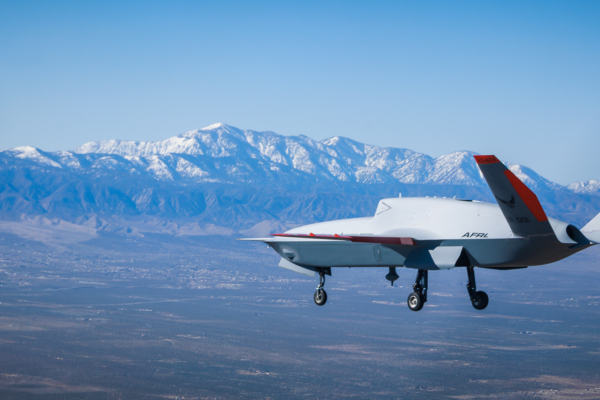The US military recently released the first test flight video of the “Collaborative Combat Aircraft” (CCA) – commonly known as the “loyal wingman” – XQ-67A drone, showcasing the progress of the XQ-67A project. This drone will serve as a loyal wingman to the US military’s sixth-generation fighter jets, enhancing their capabilities and marking a leap forward in the US Air Force’s future combat aircraft.
The XQ-67A unmanned aircraft system (UAS) was developed by General Atomics and conducted its maiden flight at the Gray Butte Field Airport in Palmdale, California, with the US Air Force capturing the over one-minute-long test flight video (watch the video by clicking here or here).
On June 26th, the US Air Force released a press release stating that the Air Force Research Laboratory (AFRL) successfully test flew the second-generation “Autonomous Collaborative Platform” (ACP) XQ-67A demonstrator on February 28, 2024, as part of the Off-Board Sensing Station (OBSS) program.
Named the “Off-Board Sensing Station,” this drone follows the XQ-58A “Valkyrie,” marking a new generation of unmanned aircraft and serving as the first aircraft in the second-generation Autonomous Collaborative Platform project.
The Air Force mentioned that the XQ-67A is the first of its kind built based on the “genus/species” concept, with its successful maiden flight demonstrating the effectiveness of this concept in speeding up aircraft replication and enhancing cost efficiency.
This concept stems from the US military’s “Low-Cost Attritable Aircraft Platform Sharing” (LCAAPS) program proposed in the 2010s, focusing on building multiple aircraft variants from a common core airframe.
“This new approach also aims to provide cost-effective advanced combat capabilities to operational personnel at an accelerated pace to address challenges in great power competition,” said the Air Force.
The new video of this collaborative combat aircraft showcases a historic moment in the Air Force’s plans, released by the Air Force Research Laboratory. The footage depicts the XQ-67A taking off at dawn, flying a short distance, and then landing back at an Air Force base.
Although the XQ-67A is a remotely piloted aircraft, it has autonomous flight capabilities. While General Atomics announced on April 24 that the XQ-67A had completed three additional test flights, the Air Force only recently released the first test flight video.
Designed as a stealthy configuration with landing gear and a tricycle layout, the aircraft features a dorsal intake, a low-swept main wing, and a V-tail aerodynamic layout.
Currently, both the US Air Force and Navy are developing CCA drones as part of the Next Generation Air Dominance (NGAD) program.
NGAD comprises two projects for developing sixth-generation combat aircraft: the Air Force is working on a manned air superiority fighter system to replace the F-22 Raptor, while the Navy is developing a versatile carrier-based fighter known as the F/A-XX to eventually replace the F/A-18 Super Hornet.
The LCAAPS program is seen as a crucial step towards developing future collaborative combat drones (CCA) as part of the US sixth-generation manned fighter aircraft program. CCA holds significant implications for the development of next-generation tactical aircraft for the US Navy and Air Force.
Considering the role of drones in recent localized conflicts like the war in Ukraine and Gaza, drones are increasingly proving their value on the battlefield. With China also heavily investing in drone technology, the XQ-67A will leverage cutting-edge technologies to counter such adversaries in future conflicts.
General Atomics previously stated, “The CCA program aims to be a force multiplier, developing a low-cost, modular unmanned drone equipped with advanced sensors or weapons to operate in conjunction with next-generation manned fighter jets.”
US military expert Kris Osborn expressed on the “Warrior Maven” website last year, “For instance, a loyal wingman drone could provide ISR (intelligence, surveillance, and reconnaissance) coverage over an area, test and overwhelm enemy air defenses, disrupt enemy communications, and even conduct offensive strikes under human command, while manned fighter jets execute command and control missions at a safer distance.”
In November last year, Air Force Secretary Frank Kendall reiterated plans to procure at least 1000 CCAs with the potential for a substantial increase in the future.
Although CCAs or “loyal wingman” drones are envisioned as a system developed around sixth-generation fighter jets, they are not exclusive to them. Airbus is developing “wingman” drones to complement the German Air Force’s existing fourth and a half-generation Eurofighter fleet, suggesting these drones can also pair with existing fourth and a half and fifth-generation fighter jets.
At the Berlin International Air Show in early June, Airbus unveiled a full-scale conceptual model of a drone called “Wingman.” The model showcased all the expected functionalities of such drones, including stealth capabilities, integration of various weapons, advanced sensors, connectivity, and collaborative solutions. According to Airbus’s vision, the “Wingman” will serve as an unmanned escort for fighter jets, controlled by pilots of current fighter jets like the Eurofighter, executing high-risk missions for manned aircraft.

